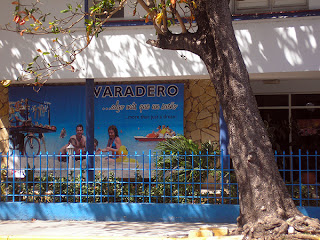Varadero is situated
between the Bay of Cardenas and the Straits of Florida 140 km east of Havana,
at the eastern end of the Via Blanca highway
The island is closed to the Cuban people with a barrier
There is a toll charge to gain access to the island
The peninsula is only 1.2 km wide at its widest point and is separated from the island of Cuba by the Kawama Channel
This spit of land however extends more than 20 kilometers from the mainland in a northeasterly direction and its tip, Punta Hicacos, is the northernmost point of the island of Cuba
At the northeastern end of the peninsula there is a nature reserve with virgin sand beaches
Nowhere in Cuba is the contrast between the tourists and Cubans more visible than in Varadero
80% Of the tourists visiting Varadero come for sun, sea and beach and see unfortunately nothing of the "real Cuba"
Juan Gualberto Gomez Airport, situated west of the peninsula,
is Varadero's airport
It`s the second-most-important airport of the island afterJode Marti Airport in Havana, and serves international and domestic flights
The first mention of Varadero was in 1555
The place was first used as a dry dock
(Spanish : varadero)
The salt mines of the peninsula (closed in 1961) supplied most of the Spanish Latin America Fleet since 1587
However, the foundation date of Varadero as city was only on December 5, 1887, when ten families from the city of Cardena obtained a permission to build their vacation homes between today's 42nd and 48th Street
It was established as municipality at the administrative re-distribution of July 3, 1976 from territories previously part of Cárdenas
In August 2010, the Varadero municipality was abolished according to a Law approved by the Cuban National Assembly, becoming again part of the Cardenas municipality
Varadero is foremost a tourist resort town, boasting more than 20 km of white sandy beaches
The first tourists visited Varadero as early as the 1870s, and for years it was considered an elite resort
In 1910 the annual rowing regatta was started; five years later the first hotel, named Varadero and later Club Nautico, was built
Tourism grew in the early 1930s as Irenee du Pont Nemours, an American millionaire, built his estate on the peninsula
Many famous and infamous people stayed in Varadero,
for example Al Capone
House of Al Capone
After the Cuban Revolution in 1959, many mansions were expropriated from their rich owners
These mansions soon became museums
The 1990s brought the start of another hotel building campaign, mostly in the 4-star and 5-star segment
Many of the hotels are operated or co-owned by foreign businesses likeMelia, Barcelo, TRYP, etc.
As international tourism was opened up, the local population expanded with the arrival of people, some in key economic positions, from other parts of Cuba
As a consequence, Varadero has lost much of its social and cultural life and its traditions
The central park, the cinema and various cultural meeting places were neglected in favor of a hotel-centred all-inclusive-tourism and finally closed
The International Carnival, an initiative of Cubans and foreigners started in the 1980s, also ceased
Varadero has natural attractions such as caves and a chain of easily accessed Varadero, which is a free port, also possesses facilities for scuba diving, deep-sea fishing, yachting and other water sports
Varadero is primarily visited by European and Canadian tourists
The number of U.S. tourists visiting Varadero, although increasing, has been limited because of the U.S. government restrictions that make it difficult for U.S. citizens to visit Cuba as tourists
Source: Wikipedia
















































































No comments:
Post a Comment
Thank you for leaving a comment. To prevent spam, I moderate all writen comments to my blogposts before publishing --- Dankjewel voor je reactie. Om spam te voorkomen, modereer ik elke reactie voordat deze definitief word geplaatst.